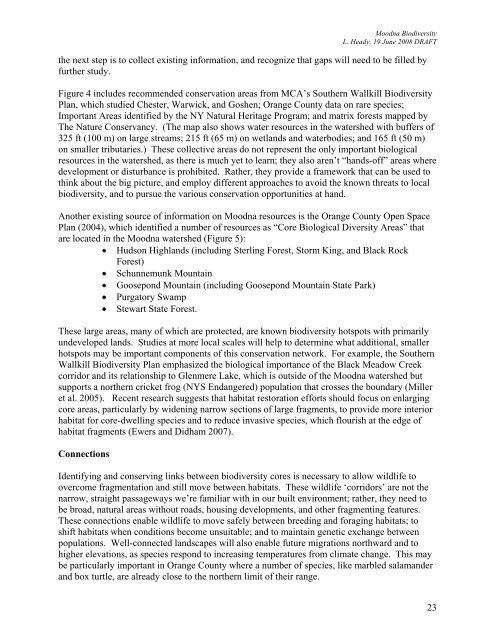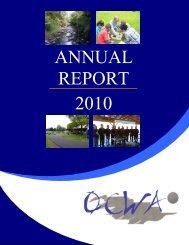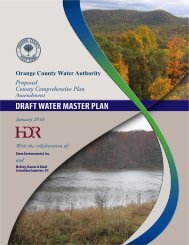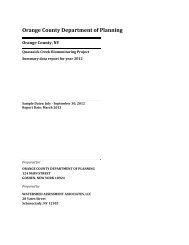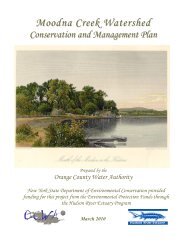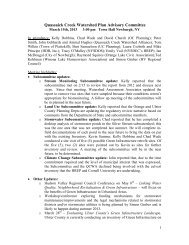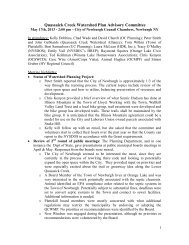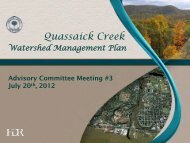Biodiversity of the Moodna Creek Watershed - Orange County Water ...
Biodiversity of the Moodna Creek Watershed - Orange County Water ...
Biodiversity of the Moodna Creek Watershed - Orange County Water ...
Create successful ePaper yourself
Turn your PDF publications into a flip-book with our unique Google optimized e-Paper software.
<strong>Moodna</strong> <strong>Biodiversity</strong><br />
L. Heady, 19 June 2008 DRAFT<br />
<strong>the</strong> next step is to collect existing information, and recognize that gaps will need to be filled by<br />
fur<strong>the</strong>r study.<br />
Figure 4 includes recommended conservation areas from MCA’s Sou<strong>the</strong>rn Wallkill <strong>Biodiversity</strong><br />
Plan, which studied Chester, Warwick, and Goshen; <strong>Orange</strong> <strong>County</strong> data on rare species;<br />
Important Areas identified by <strong>the</strong> NY Natural Heritage Program; and matrix forests mapped by<br />
The Nature Conservancy. (The map also shows water resources in <strong>the</strong> watershed with buffers <strong>of</strong><br />
325 ft (100 m) on large streams; 215 ft (65 m) on wetlands and waterbodies; and 165 ft (50 m)<br />
on smaller tributaries.) These collective areas do not represent <strong>the</strong> only important biological<br />
resources in <strong>the</strong> watershed, as <strong>the</strong>re is much yet to learn; <strong>the</strong>y also aren’t “hands-<strong>of</strong>f” areas where<br />
development or disturbance is prohibited. Ra<strong>the</strong>r, <strong>the</strong>y provide a framework that can be used to<br />
think about <strong>the</strong> big picture, and employ different approaches to avoid <strong>the</strong> known threats to local<br />
biodiversity, and to pursue <strong>the</strong> various conservation opportunities at hand.<br />
Ano<strong>the</strong>r existing source <strong>of</strong> information on <strong>Moodna</strong> resources is <strong>the</strong> <strong>Orange</strong> <strong>County</strong> Open Space<br />
Plan (2004), which identified a number <strong>of</strong> resources as “Core Biological Diversity Areas” that<br />
are located in <strong>the</strong> <strong>Moodna</strong> watershed (Figure 5):<br />
• Hudson Highlands (including Sterling Forest, Storm King, and Black Rock<br />
Forest)<br />
• Schunnemunk Mountain<br />
• Goosepond Mountain (including Goosepond Mountain State Park)<br />
• Purgatory Swamp<br />
• Stewart State Forest.<br />
These large areas, many <strong>of</strong> which are protected, are known biodiversity hotspots with primarily<br />
undeveloped lands. Studies at more local scales will help to determine what additional, smaller<br />
hotspots may be important components <strong>of</strong> this conservation network. For example, <strong>the</strong> Sou<strong>the</strong>rn<br />
Wallkill <strong>Biodiversity</strong> Plan emphasized <strong>the</strong> biological importance <strong>of</strong> <strong>the</strong> Black Meadow <strong>Creek</strong><br />
corridor and its relationship to Glenmere Lake, which is outside <strong>of</strong> <strong>the</strong> <strong>Moodna</strong> watershed but<br />
supports a nor<strong>the</strong>rn cricket frog (NYS Endangered) population that crosses <strong>the</strong> boundary (Miller<br />
et al. 2005). Recent research suggests that habitat restoration efforts should focus on enlarging<br />
core areas, particularly by widening narrow sections <strong>of</strong> large fragments, to provide more interior<br />
habitat for core-dwelling species and to reduce invasive species, which flourish at <strong>the</strong> edge <strong>of</strong><br />
habitat fragments (Ewers and Didham 2007).<br />
Connections<br />
Identifying and conserving links between biodiversity cores is necessary to allow wildlife to<br />
overcome fragmentation and still move between habitats. These wildlife ‘corridors’ are not <strong>the</strong><br />
narrow, straight passageways we’re familiar with in our built environment; ra<strong>the</strong>r, <strong>the</strong>y need to<br />
be broad, natural areas without roads, housing developments, and o<strong>the</strong>r fragmenting features.<br />
These connections enable wildlife to move safely between breeding and foraging habitats; to<br />
shift habitats when conditions become unsuitable; and to maintain genetic exchange between<br />
populations. Well-connected landscapes will also enable future migrations northward and to<br />
higher elevations, as species respond to increasing temperatures from climate change. This may<br />
be particularly important in <strong>Orange</strong> <strong>County</strong> where a number <strong>of</strong> species, like marbled salamander<br />
and box turtle, are already close to <strong>the</strong> nor<strong>the</strong>rn limit <strong>of</strong> <strong>the</strong>ir range.<br />
23


